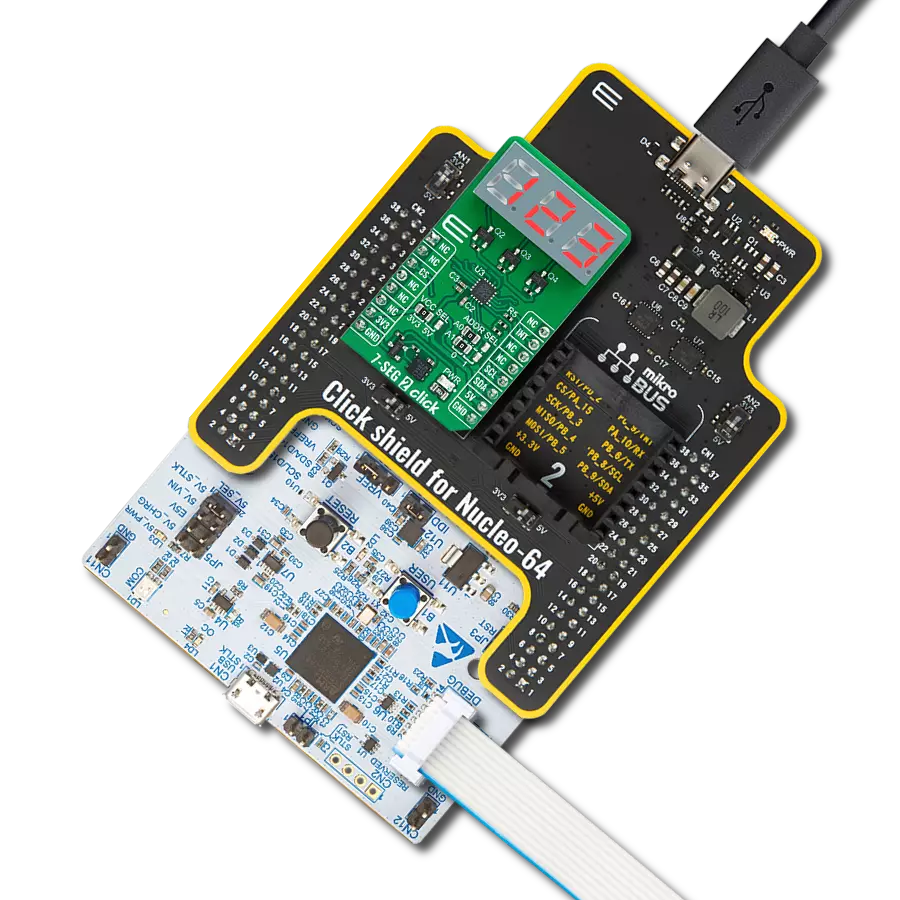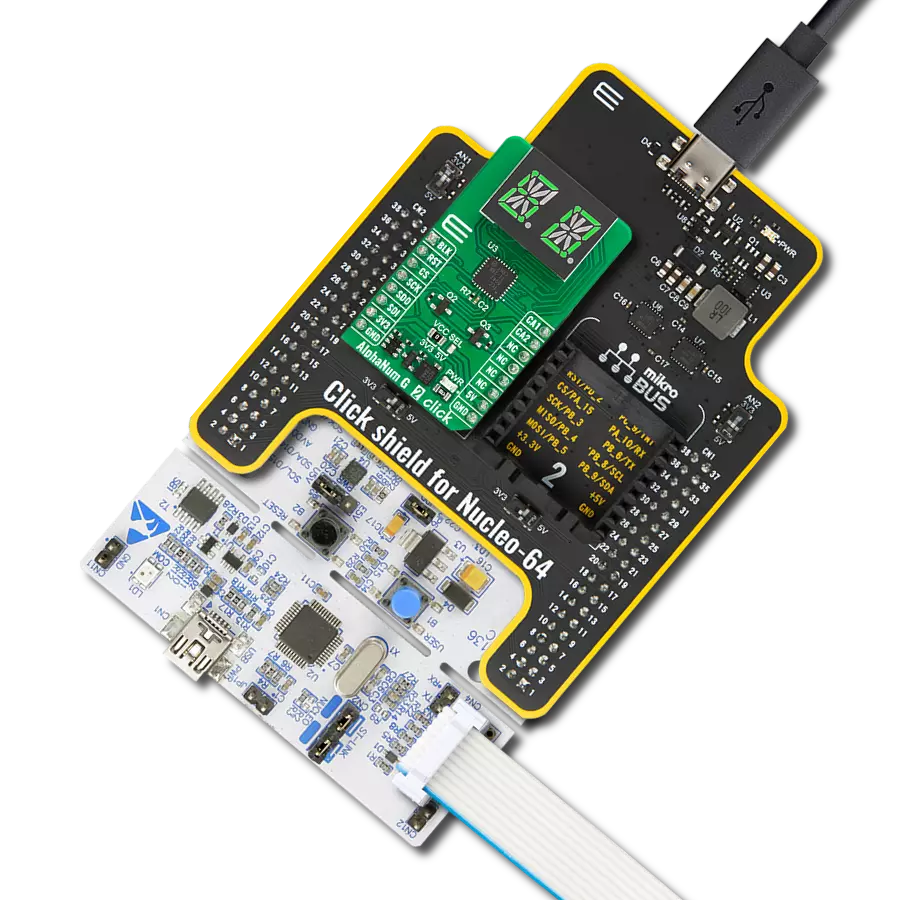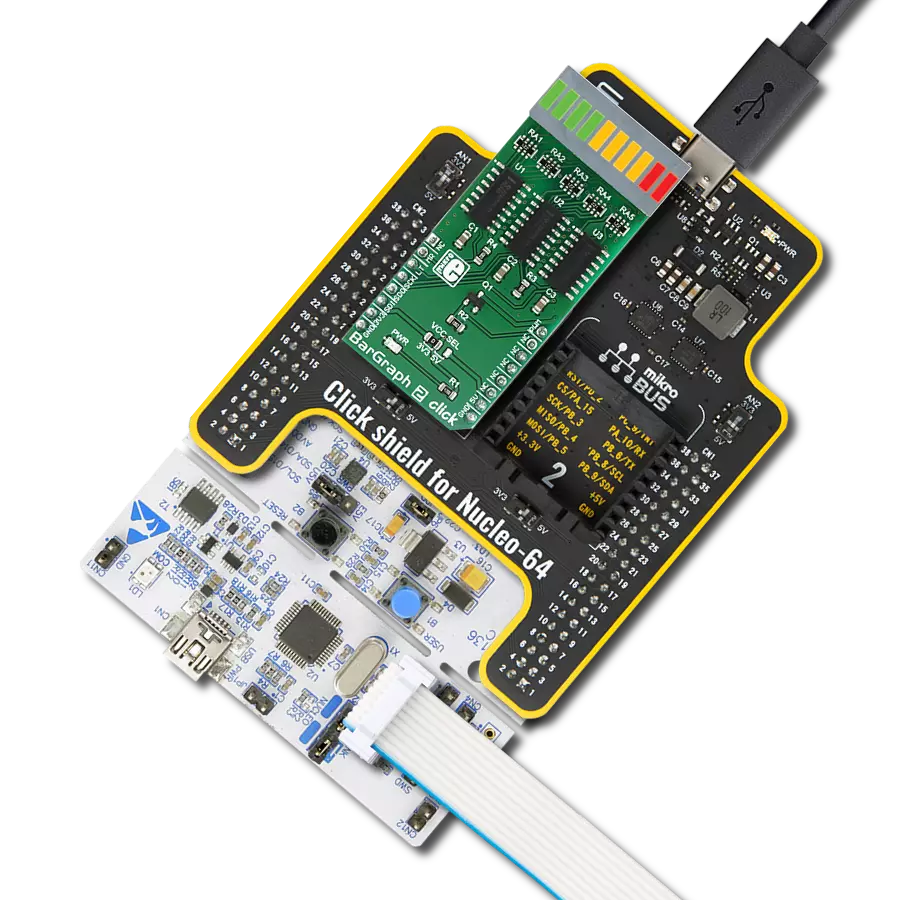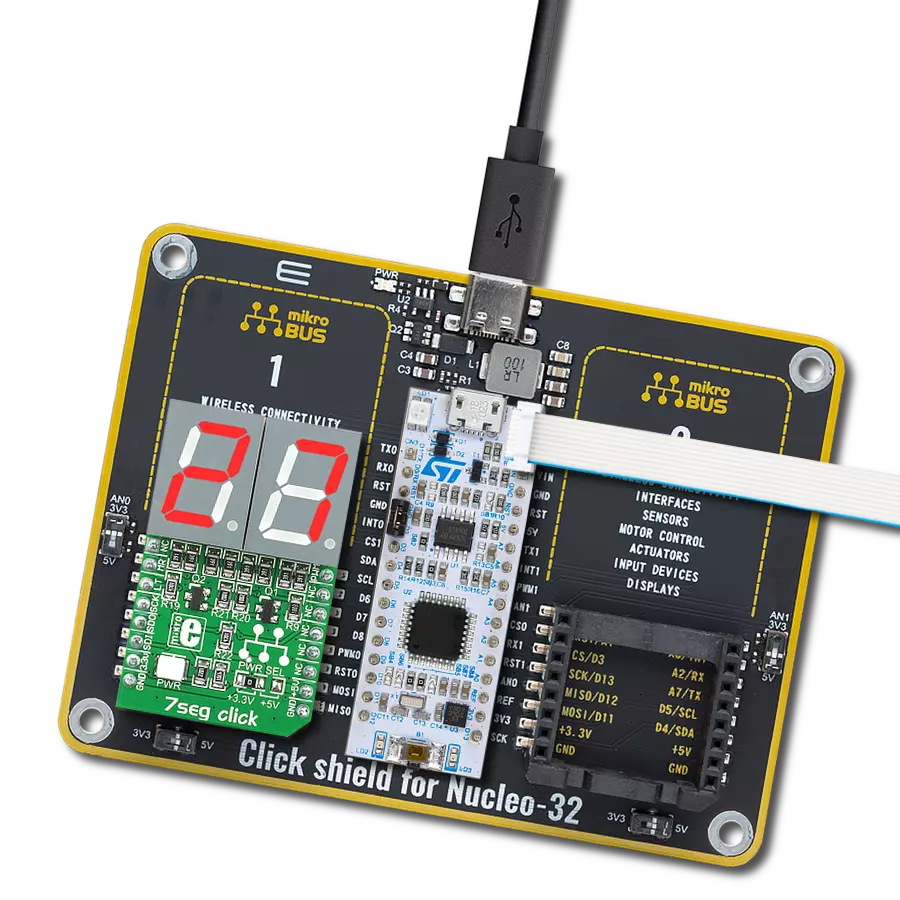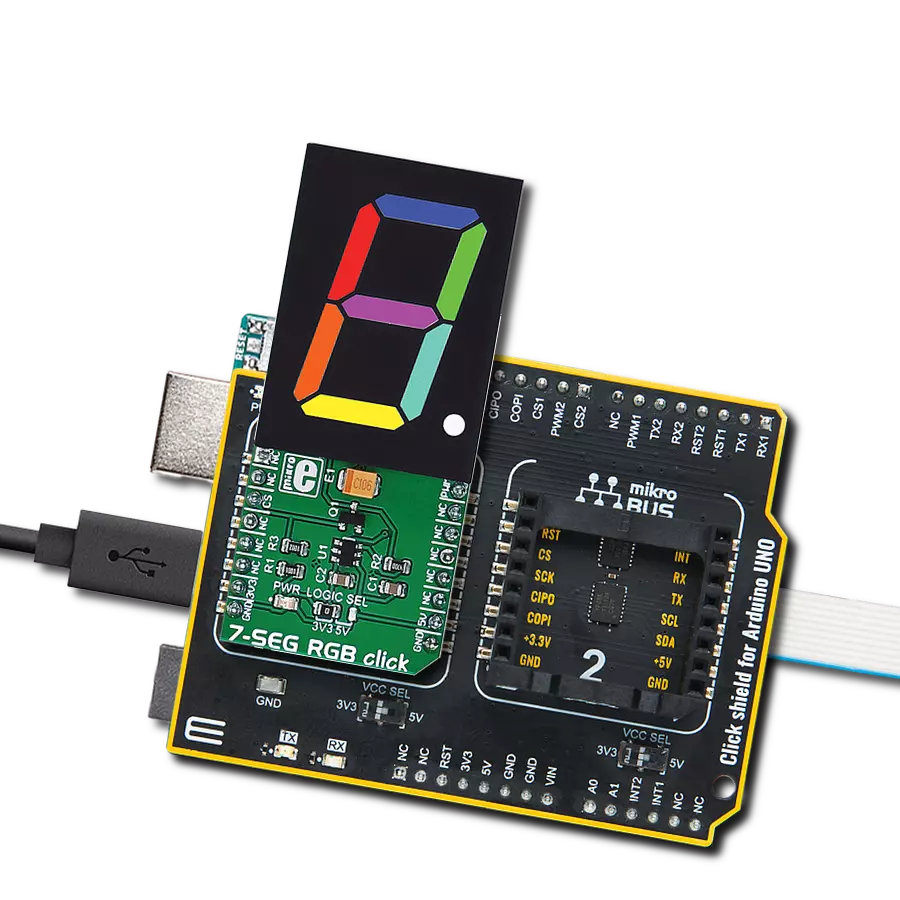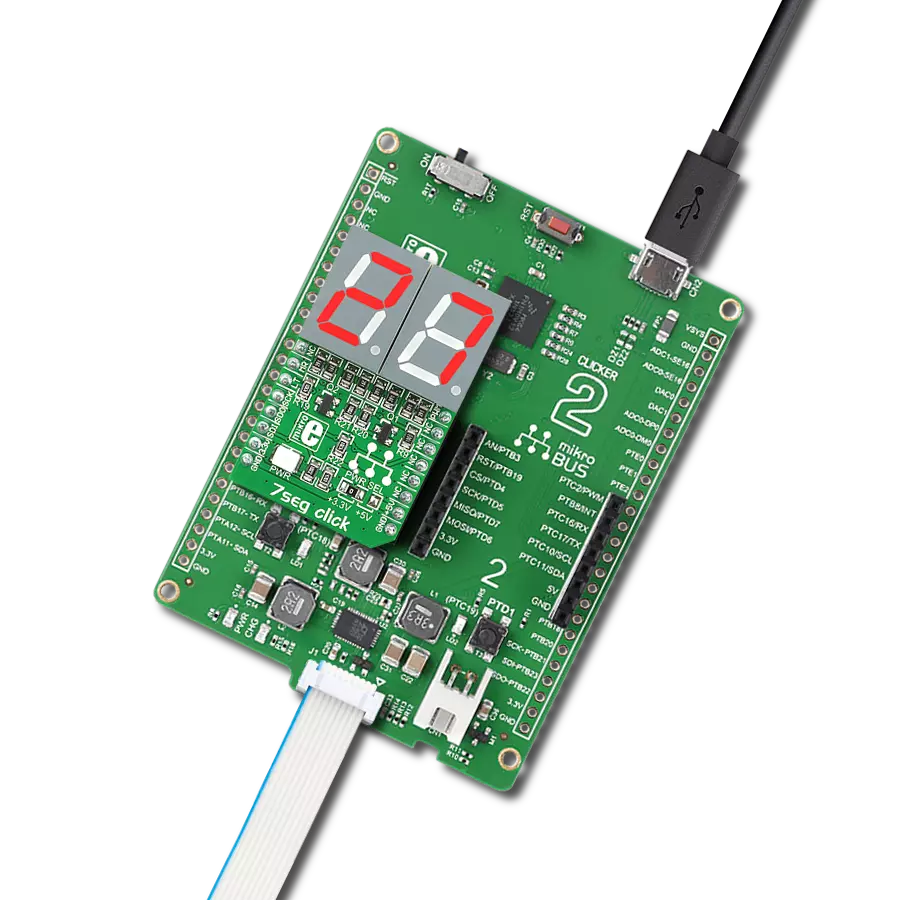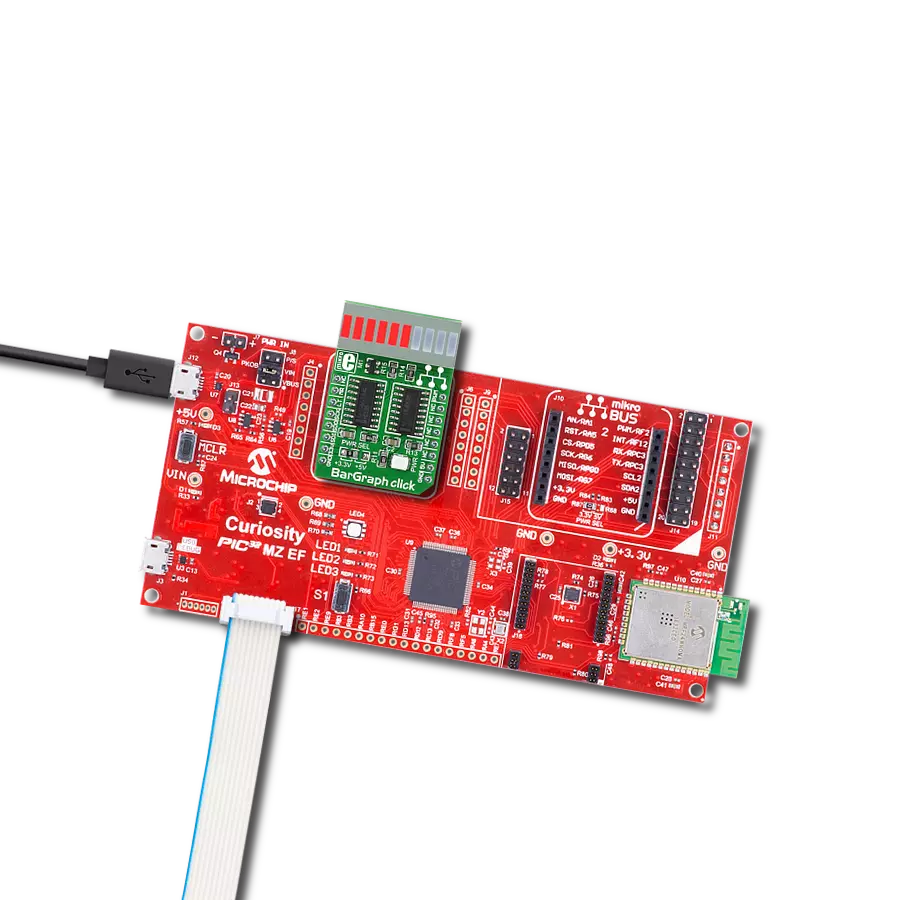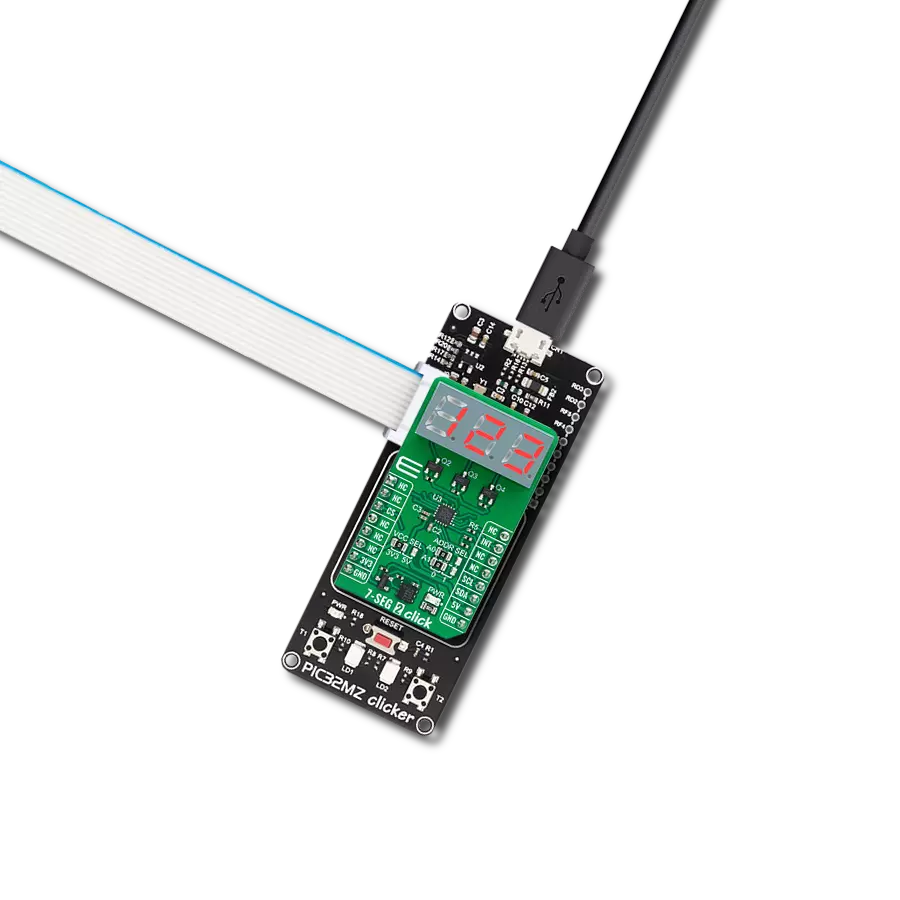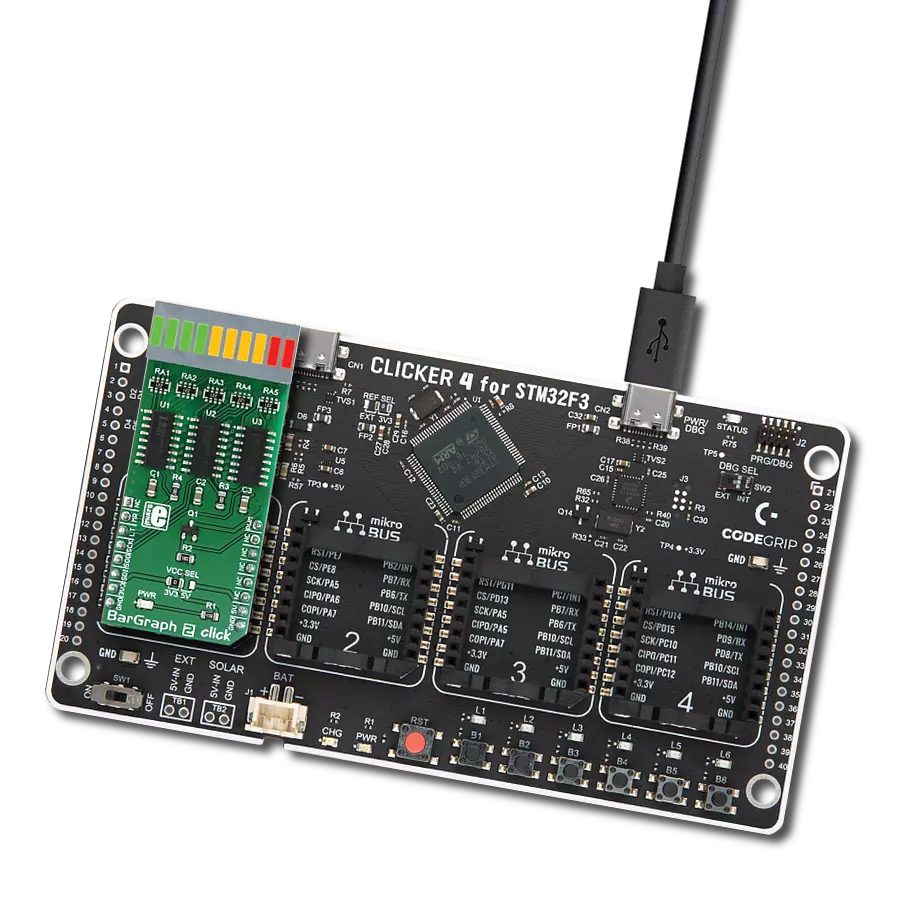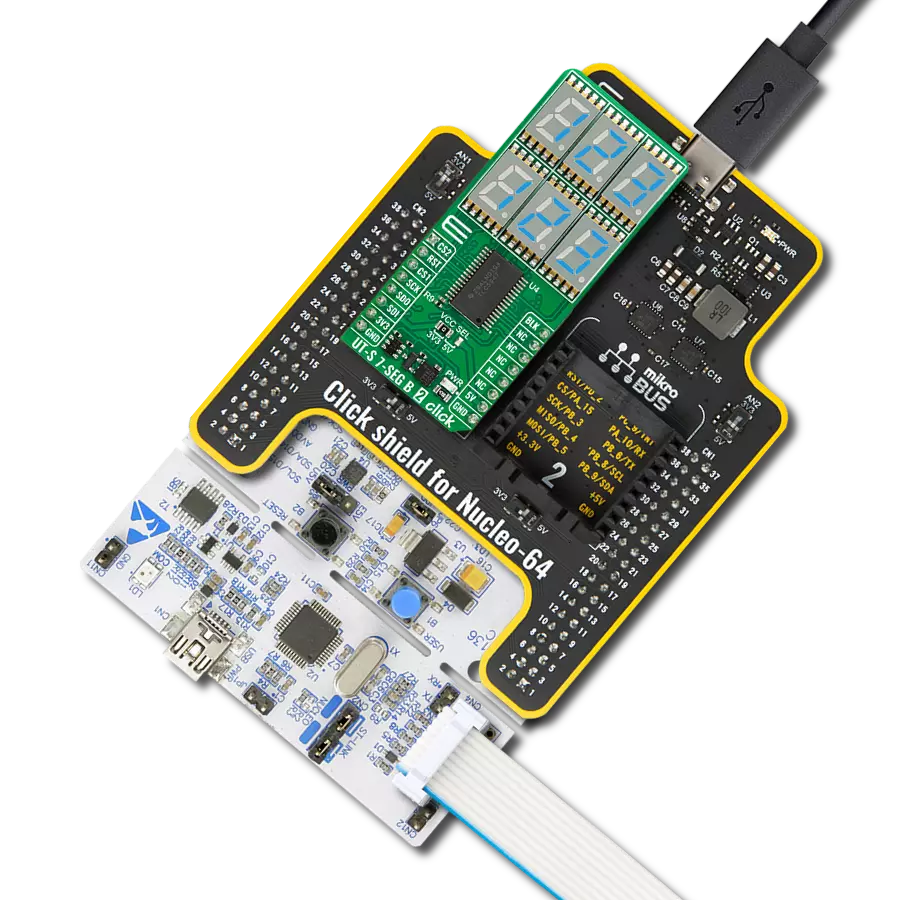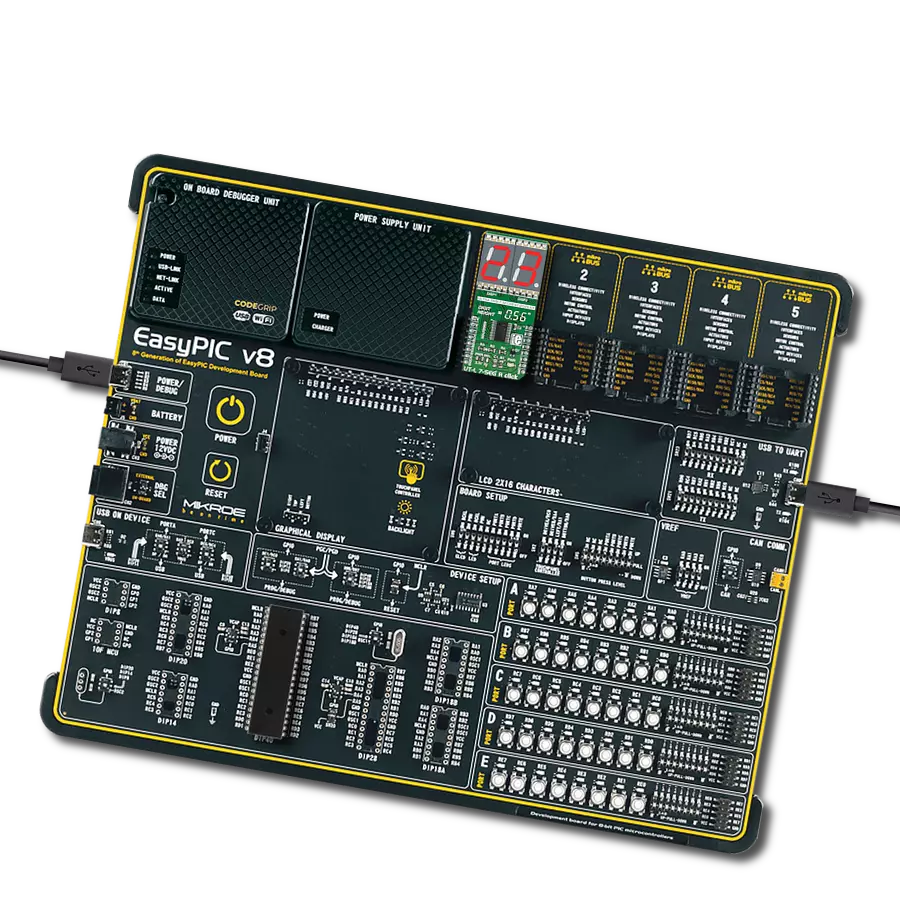Visually indicate network status, signal strength, or show messages or alerts using a bargraph format
A
A
Hardware Overview
How does it work?
BarGraph 5 Click is based on three HLMP-2685 red LED bargraph displays from Broadcom Limited controlled by the TLC5947, a 12-bit PWM LED driver with an internal oscillator from Texas Instruments. These rectangular red light bars are housed in single-in-line packages, making them perfect for various industrial and commercial applications. Each lighting segment delivers a typical luminous intensity of 83.4mcd, with a peak wavelength of 626nm, ensuring high visibility. This Click board™ is ideal for applications requiring a large, bright, uniform light source, such as typical bargraph displays, front panel process status
indicators, telecommunications equipment, machine message annunciators, and many other scenarios where clear and reliable visual feedback is needed. The TLC5947 that controls these bars communicates with the host MCU through an SPI serial interface with a maximum clock frequency of up to 30MHz. In addition to the SPI communication signals, the board uses the BLK pin from the mikroBUS™ socket, functioning as a blanking control. When the BLK pin is set to a HIGH logic level, all bargraphs are turned OFF, and when it's LOW, the bargraphs are activated. The board also includes a 2kΩ IREF resistor that sets the current
for the TLC5947's LED driver channels. This resistor ensures that the current for the bargraph LEDs is regulated at approximately 20mA, providing consistent brightness across the displays. This Click board™ can operate with either 3.3V or 5V logic voltage levels selected via the VCC SEL jumper. This way, both 3.3V and 5V capable MCUs can use the communication lines properly. Also, this Click board™ comes equipped with a library containing easy-to-use functions and an example code that can be used as a reference for further development.
Features overview
Development board
PIC18F57Q43 Curiosity Nano evaluation kit is a cutting-edge hardware platform designed to evaluate microcontrollers within the PIC18-Q43 family. Central to its design is the inclusion of the powerful PIC18F57Q43 microcontroller (MCU), offering advanced functionalities and robust performance. Key features of this evaluation kit include a yellow user LED and a responsive
mechanical user switch, providing seamless interaction and testing. The provision for a 32.768kHz crystal footprint ensures precision timing capabilities. With an onboard debugger boasting a green power and status LED, programming and debugging become intuitive and efficient. Further enhancing its utility is the Virtual serial port (CDC) and a debug GPIO channel (DGI
GPIO), offering extensive connectivity options. Powered via USB, this kit boasts an adjustable target voltage feature facilitated by the MIC5353 LDO regulator, ensuring stable operation with an output voltage ranging from 1.8V to 5.1V, with a maximum output current of 500mA, subject to ambient temperature and voltage constraints.
Microcontroller Overview
MCU Card / MCU
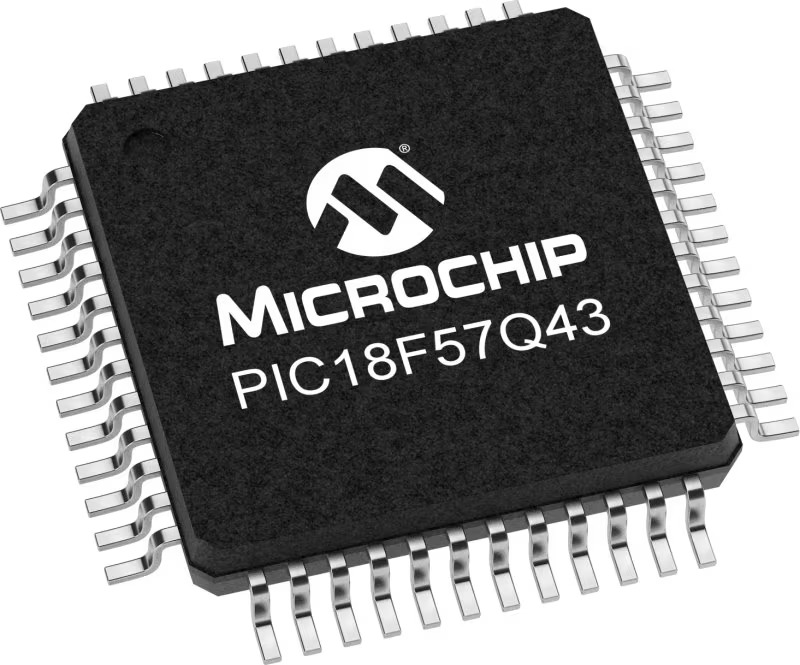
Architecture
PIC
MCU Memory (KB)
128
Silicon Vendor
Microchip
Pin count
48
RAM (Bytes)
8196
You complete me!
Accessories
Curiosity Nano Base for Click boards is a versatile hardware extension platform created to streamline the integration between Curiosity Nano kits and extension boards, tailored explicitly for the mikroBUS™-standardized Click boards and Xplained Pro extension boards. This innovative base board (shield) offers seamless connectivity and expansion possibilities, simplifying experimentation and development. Key features include USB power compatibility from the Curiosity Nano kit, alongside an alternative external power input option for enhanced flexibility. The onboard Li-Ion/LiPo charger and management circuit ensure smooth operation for battery-powered applications, simplifying usage and management. Moreover, the base incorporates a fixed 3.3V PSU dedicated to target and mikroBUS™ power rails, alongside a fixed 5.0V boost converter catering to 5V power rails of mikroBUS™ sockets, providing stable power delivery for various connected devices.
Used MCU Pins
mikroBUS™ mapper
Take a closer look
Click board™ Schematic
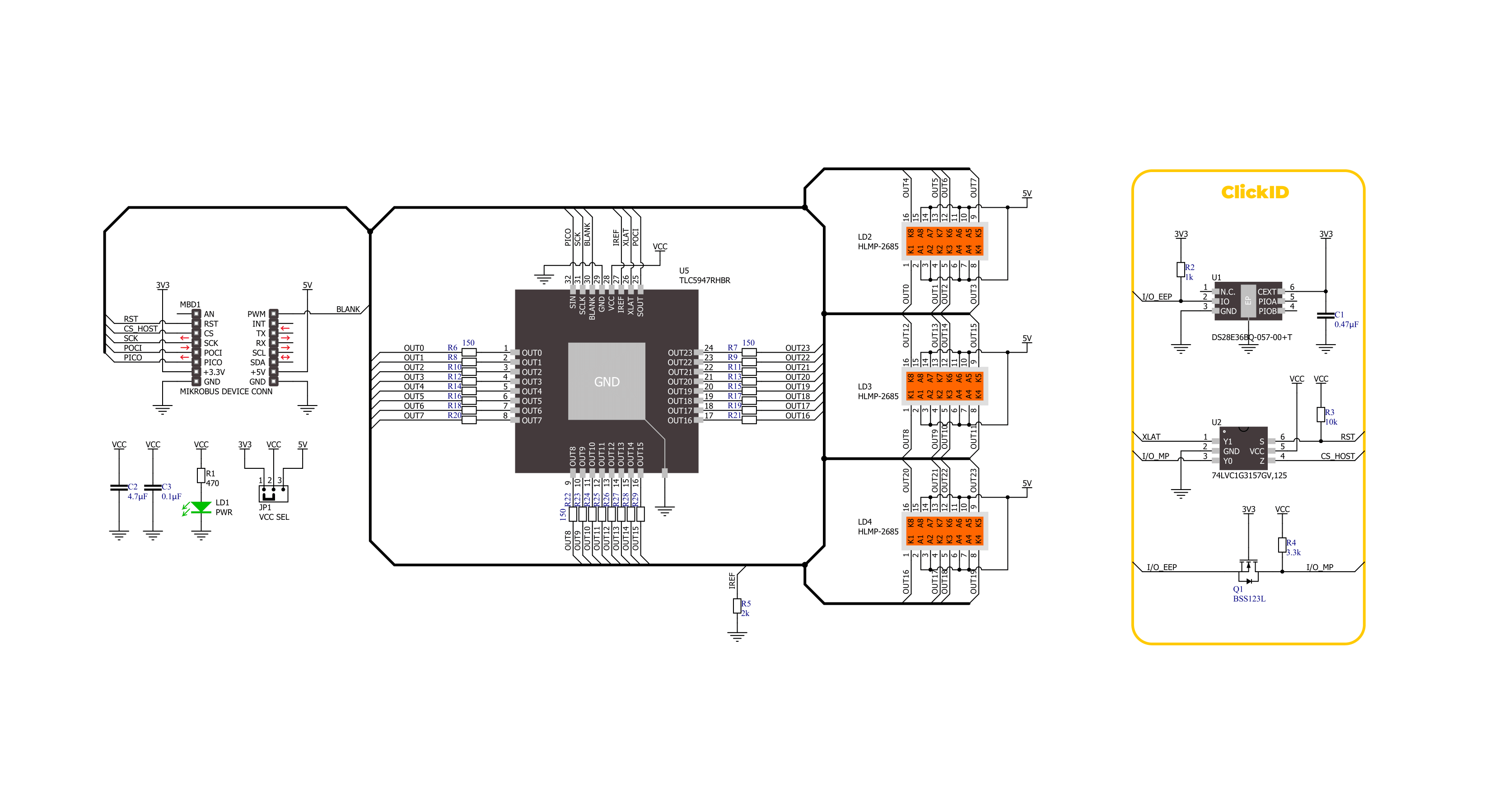
Step by step
Project assembly
Software Support
Library Description
This library contains API for BarGraph 5 Click driver.
Key functions:
bargraph5_set_bar_level- This function sets the level of a selected BarGraph channel at the selected brightness.bargraph5_output_enable- This function enables the BarGraph LEDs output by setting the BLANK pin to low logic state.bargraph5_output_disable- This function disables the BarGraph LEDs output by setting the BLANK pin to high logic state.
Open Source
Code example
The complete application code and a ready-to-use project are available through the NECTO Studio Package Manager for direct installation in the NECTO Studio. The application code can also be found on the MIKROE GitHub account.
/*!
* @file main.c
* @brief BarGraph 5 Click example
*
* # Description
* This example demonstrates the use of BarGraph 5 Click board by changing
* the level of all BarGraph output channels.
*
* The demo application is composed of two sections :
*
* ## Application Init
* Initializes the driver and performs the Click default configuration.
*
* ## Application Task
* Changes the level of all BarGraph channels once per second.
* The channels level is displayed on the USB UART.
*
* @author Stefan Filipovic
*
*/
#include "board.h"
#include "log.h"
#include "bargraph5.h"
static bargraph5_t bargraph5;
static log_t logger;
void application_init ( void )
{
log_cfg_t log_cfg; /**< Logger config object. */
bargraph5_cfg_t bargraph5_cfg; /**< Click config object. */
/**
* Logger initialization.
* Default baud rate: 115200
* Default log level: LOG_LEVEL_DEBUG
* @note If USB_UART_RX and USB_UART_TX
* are defined as HAL_PIN_NC, you will
* need to define them manually for log to work.
* See @b LOG_MAP_USB_UART macro definition for detailed explanation.
*/
LOG_MAP_USB_UART( log_cfg );
log_init( &logger, &log_cfg );
log_info( &logger, " Application Init " );
// Click initialization.
bargraph5_cfg_setup( &bargraph5_cfg );
BARGRAPH5_MAP_MIKROBUS( bargraph5_cfg, MIKROBUS_1 );
if ( SPI_MASTER_ERROR == bargraph5_init( &bargraph5, &bargraph5_cfg ) )
{
log_error( &logger, " Communication init." );
for ( ; ; );
}
if ( BARGRAPH5_ERROR == bargraph5_default_cfg ( &bargraph5 ) )
{
log_error( &logger, " Default configuration." );
for ( ; ; );
}
log_info( &logger, " Application Task " );
}
void application_task ( void )
{
for ( bargraph5_level_t cnt = BARGRAPH5_LEVEL_0; cnt <= BARGRAPH5_LEVEL_4; cnt++ )
{
bargraph5_set_bar_level ( &bargraph5, BARGRAPH5_BAR_0, cnt, BARGRAPH5_BRIGHTNESS_DEFAULT );
bargraph5_set_bar_level ( &bargraph5, BARGRAPH5_BAR_1, BARGRAPH5_LEVEL_4 - cnt, BARGRAPH5_BRIGHTNESS_DEFAULT );
bargraph5_set_bar_level ( &bargraph5, BARGRAPH5_BAR_2, cnt, BARGRAPH5_BRIGHTNESS_DEFAULT );
bargraph5_set_bar_level ( &bargraph5, BARGRAPH5_BAR_3, BARGRAPH5_LEVEL_4 - cnt, BARGRAPH5_BRIGHTNESS_DEFAULT );
bargraph5_set_bar_level ( &bargraph5, BARGRAPH5_BAR_4, cnt, BARGRAPH5_BRIGHTNESS_DEFAULT );
bargraph5_set_bar_level ( &bargraph5, BARGRAPH5_BAR_5, BARGRAPH5_LEVEL_4 - cnt, BARGRAPH5_BRIGHTNESS_DEFAULT );
log_printf( &logger, " Bars 0-2-4 level: %u\r\n", ( uint16_t ) cnt );
log_printf( &logger, " Bars 1-3-5 level: %u\r\n\n", ( uint16_t ) ( BARGRAPH5_LEVEL_4 - cnt ) );
Delay_ms ( 1000 );
}
}
int main ( void )
{
/* Do not remove this line or clock might not be set correctly. */
#ifdef PREINIT_SUPPORTED
preinit();
#endif
application_init( );
for ( ; ; )
{
application_task( );
}
return 0;
}
// ------------------------------------------------------------------------ END
Additional Support
Resources
Category:LED Segment



















